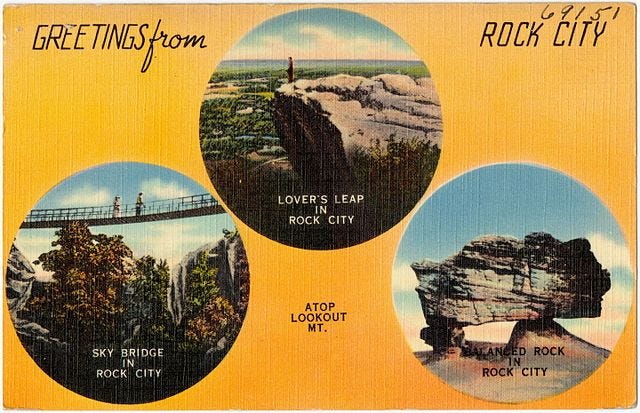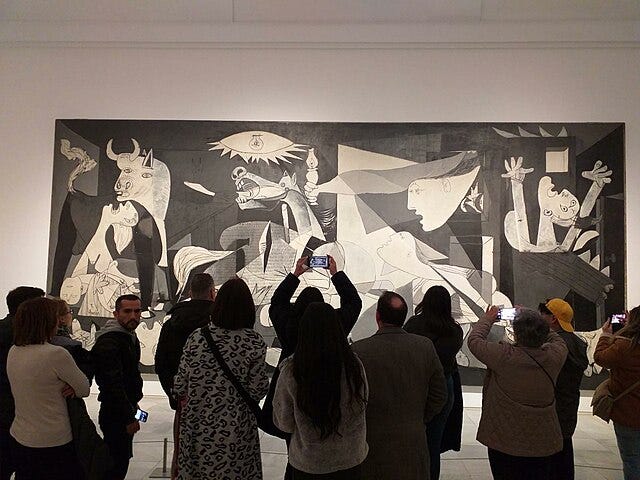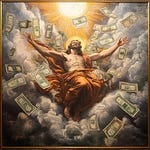Every year my wife and I pick a book to read together at Christmas.
This year we chose American Gods. One of my all-time favorite books. No, my all-time favorite book. The timing was, shall we say, impeccable.
Christmas before last my wife got me this beautiful annotated edition. I was thrilled to get it. Finally I could get all the references! The weirdest arcana about German wood spirits and shit.
I must admit I was disappointed to learn that Neil Gaiman did not do the annotating. That was done by a whole other person, a meticulous researcher named Leslie S. Klinger (who did a brilliant job, by the way). But I also learned that this is just how annotation works. It’s typically not the original author doing the annotating. Seems obvious, I guess, now that I think about it, but I had never thought about it.
Before I had even read American Gods I fell in love with House on the Rock. I found House on the Rock in the best way a person can find House on the Rock, completely by happenstance.
I was on a weekend motorcycle trip with a buddy to Madison. An annual tradition, we’d pick some place and ride our bikes there. I had heard about Taliesin, Frank Lloyd Wright’s artist colony where his lover, two children, and six others were murdered by by a deranged laborer. So we rode our bikes out there and were checking out the tour and the next one wasn’t for like two hours… and there’s this whole other attraction just a few miles up the road.
House in the Rock blew my mind. If you’ve never been there you have got to make a trip. It is the weirdest place on earth and I loved seeing all that crazy shit. The Infinity room. The Mikado. The whale. The carousel of course.
When I got back from the trip I wanted to know more about this place. And that’s how I found my favorite book, American Gods.
I don’t know why this book resonated with me so much. I loved Gaiman’s creativity. I loved how he used the entire pantheon of all the world’s gods and made something completely unique and beautiful. I loved Gaiman’s style and plotting. I love the imagery he creates. The first time I read this book I thought it was the best book I had ever read.
I’m not a person who goes back and rereads their favorite books a hundred times. I am too much of a Sagittarius. I am too curious about all the other stuff I haven’t read to go back and read something over and over again.
But part of me wanted to know… would this book still hit the same way? It’s been more than a decade since I discovered this book. Since then I’ve read just about everything I could find written by Neil Gaiman. I loved Graveyard Book, shared that one with the kids. Neverwhere was so much fun. The series was okay. Stardust I loved, the movie too. Not quite transcendent but a rollicking, star studded cliff notes version of the book. Many short stories and comics. Sandman of course. The comics and the series. Fantastic. Amazing.
I was disappointed in the American Gods TV series. I loved the original story too much to tolerate the kind of changes they wanted to make.
I borrowed a copy of the American Gods graphic novel series from the library. Really enjoyed that. Fun to see it visualized that way.
Does the book hold up?
Yes, definitely.
Having the annotated version was frequently distracting. But I just recently read Robert Greene’s Art of Seduction so I was ready. Far too many of the notations were about changes in the body of the text since the first edition. On balance I’d say that most of the changes Gaiman made were great improvements. But the place the annotations really shine is with all those weird little references Gaiman makes to different gods, giants, culture heroes, and faerie folk. During the final battle royale at Rock City I was in heaven.
Reading American Gods this time, after finally getting my hands on Gaiman’s Sandman I could see some recycling of ideas. Newer iterations. I liked catching those references this time around. The annotations helped make sure I didn’t miss any.
Of course as I alluded to in my introduction, this was an ill-fated time to be enjoying my favorite book. Gruesome new details. Upsetting headlines about our star author, Mr. Neil Gaiman. Ripe for cancellation.
It makes me sad. It bums me out. I will not diminish the gravity of the things Gaiman is accused of, some quite sickening.
It seems like modern audiences have a really hard time separating art from the artist. I feel like once allegations are leveled against an artist people are expected to forget or change their opinion about the quality of that person’s art. Which isn’t always easy to do. Pablo Picasso probably got up to much worse than Gaiman is accused of. Does that make Guernica any less stunning to behold? Does that make The Old Guitarist any less beautiful?
If the woman who was sent Van Gogh’s ear had written a tell all book about how receiving body parts in the mail scarred her for life, would we find his paintings any less sublime?
It becomes art with an asterisk. The asterisk warns people - while this art may be great, the artist was a heel. A sinner. What we call a bad person. A moral judgment has been made by this generation. Condemnation. Rejection. Will subsequent generations agree? Will they care even more about the ethics of artists? I have my doubts.
Why do modern audiences demand our artists be moral paragons? Artists have always been outsiders, nonconformists, rebels. Do any moral paragons even exist today? Human beings are imperfect, complex. It’s hardly shocking that one of modern literature’s most creative minds is a freak in private.
American Gods is still one of my favorite books. Even if Gaiman was a murderer or supported Israel, the brilliance of his work cannot be denied. But now there is an asterisk to contend with. So it goes.
I’m not saying we should look the other way. I’m not saying we should forgive and forget. I just wonder how much the moral fiber of an artist should matter when we engage with great art. I think the best art will endure whether we approve of the artist or not.
























Share this post